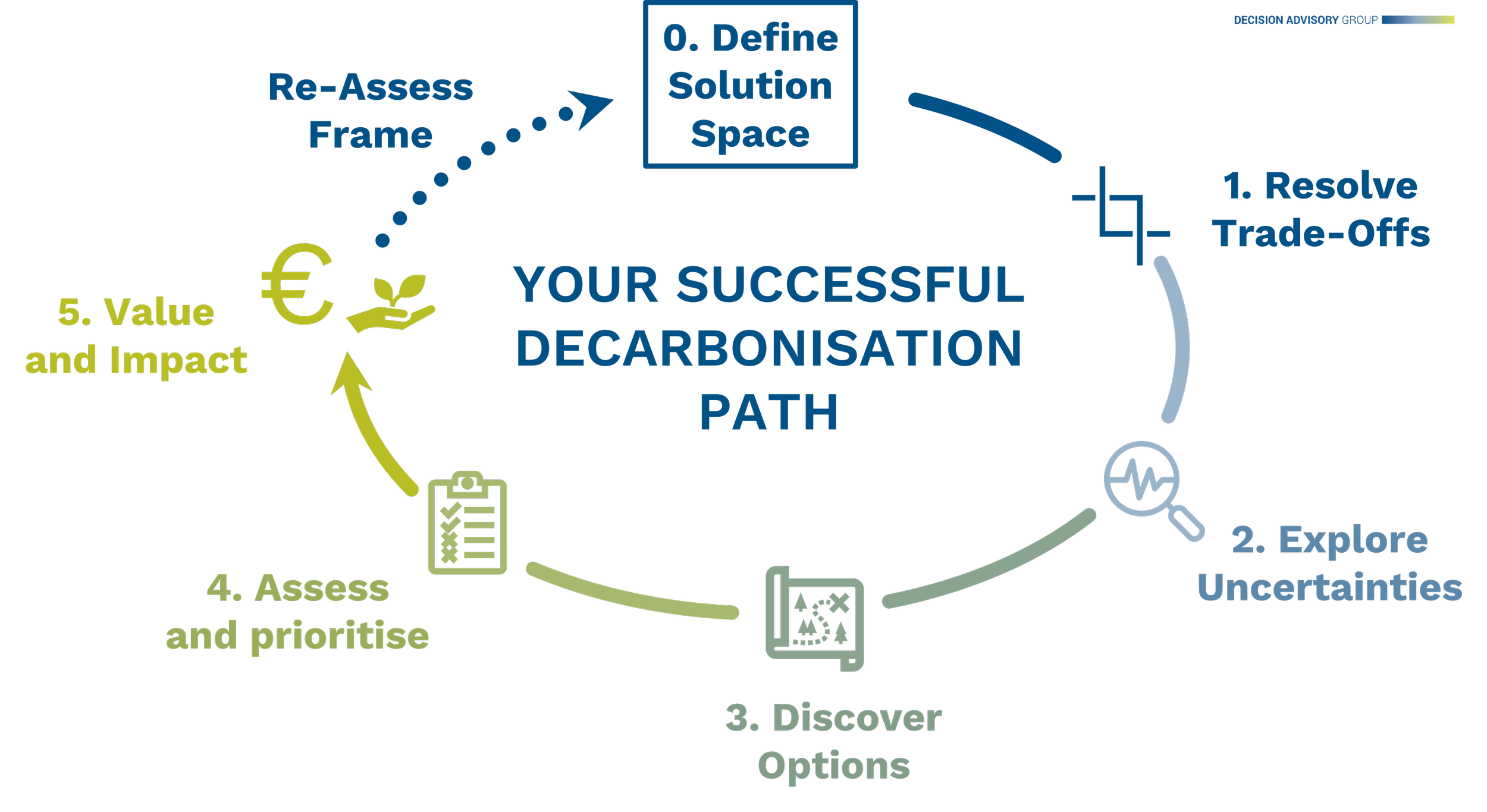Your successful Decarbonisation path
One critical definition plus 5 essential steps
to make your decarbonisation journey a success
Are you working on your decarbonisation plan? Maybe you already set some mid- and long-term targets for your CO2 emission reduction and even developed a roadmap with a financial plan on your way to net-zero. So, in theory at least achieving that goal is only a question of time.
However, you are going to face a number of challenges on the way to a successful decarbonisation:
Your plan needs to be robust in the face of volatilities and disruptions that happen all too frequently nowadays. Are your base assumptions too optimistic or too focused?
Your transformation is developed from an internal perspective and fails to take the risk into account that your peers might develop a competitive edge during that transformation (e.g., by creating an early-mover advantage on the market or by securing critical resources first). Do you understand your competitors opportunities and risks for the transformation?
By introducing a net zero goal next to your financial goals you are targeting two potentially conflicting objectives. Not addressing those trade-offs is a source of ongoing conflict between stakeholders. How much are you prepared to pay for your decarbonisation efforts?
You may be betting on the wrong alternative(s) or miss promising opportunities because your defined scope is too narrow. How confident are you that explored the entire solution space in the search for the best option?
You have difficulties evaluating and selecting the most promising option(s). This is especially true when you must select between immature technology options. Are you stuck in analysis paralysis?
You will benefit from setting the stage and five steps for making your decarbonization journey a success
0. Define your solution space
Start with discussing WHY the transformation is required. Set the solution frame wide enough to ensure that you do not miss out on the best course of action. Once you have alignment with all decision makers you have immediate ability to kick-off your journey
1. Resolve trade-offs
Set ambitious goals and define targets and prepare for dealing with trade-offs mainly coming from potentially conflicting financial and carbon reduction goals. This will allow for faster and transparent decisions
2. Explore uncertainties
Decarbonisation will lead to a new industrial revolution. However, the path and destination are fraught with uncertainties. Prepare for those uncertainties by developing scenarios and assessing implications for each scenario. This builds the basis for a resilient plan and allows fast reactions to changes
3. Discover options
Most industries don’t have a silver bullet that solves their decarbonisation challenge. Most solutions require specific framework conditions which are all uncertain. Armed with your scenarios, develop a portfolio of options to assess. The answer lies in managing a portfolio which will include winning solutions for each scenario.
4. Assess and prioritise
Evaluating different options under different scenarios against different objectives is more than the typical business case analysis. You need the right tools to identify the most promising options in a comprehensible way without getting lost in analysis paralysis. This includes identifying the key drivers and their impact for each alternative under different scenarios. This will serve as a basis for discussions on how to improve the risk/return profile. The result is a transparent presentation of the expected benefits, risks and opportunity potential for each option to allow for prioritisation of options and the development of a roadmap.
5. Value & impact
Implementation matters. Given the volatile framework conditions implementation needs to follow an agile approach. The portfolio is continuously developed and optimized, sprints allow for regular validation of emerging options and/or changing framework conditions. This ensures value maximisation during the transformation and allows development of a competitive edge in a decarbonised industry.
Re-Assessment of the Frame
In some cases the first iteration of the process will not deliver the desired result with an economic and feasible pathway to Net Zero emissions. To overcome that dead-lock, the frame of the whole decarbonisation program needs to be challenged. A broader solution space might allow new strategic and technical options, such as approaching new energy sources, partnerships along the value-chain, location changes and many more.
When working on your decarbonisation plan, you face major uncertainties, such as the speed and impact of energy transition, the availability of technologies, costs, and market developments. The iterative approach above addresses the challenges of decarbonisation and takes account of your specific conditions.
The following chart summarises how each step delivers distinct results and added value along the process.
The DAG Core Model - Adding value step by step
Are there any other steps you would add to this process to ensure a successful transformation?


